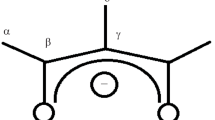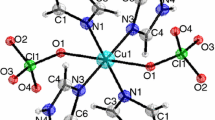Abstract
The sublimation vapor pressures of three metallic (group 6) hexacarbonyls, Cr(CO)6, Mo(CO)6, and W(CO)6, were measured using the Knudsen mass-loss effusion method. The standard (po = 0.1 MPa) molar enthalpies, entropies, Gibbs energies, and heat capacity difference between the gas and solid state, at T = 298.15 K, were derived from the experimental results combined with selected literature ones covering a wide range of temperature. The temperatures and molar enthalpies of fusion of those compounds were measured using differential scanning calorimetry. The thermodynamic stability of the hexacarbonyls was evaluated taking into account the standard Gibbs energies of formation in the crystalline and gaseous phases. Gas-phase absolute entropies, heat capacities, and enthalpies of formation of the three compounds studied as well as the bond distances M–C and C–O were calculated.




Similar content being viewed by others
References
Iranpoor N, Firouzabadi H, Etemadi-Davan E, Nematollahi A, Firouzi HR. Novel nickel-catalyzed synthesis of thioesters, esters and amides from aryl iodides in the presence of chromium hexacarbonyl. New J Chem. 2015;39:6445–52.
Lagerlund O, Larhed M. Microwavepromoted aminocarbonylations of aryl chlorides using Mo(CO)6 as a solid carbonmonoxide source. J Comb Chem. 2006;8:4–6.
Wu X, Nilsson P, Larhed M. Microwave-enhanced carbonylative generation of indanones and 3-acylaminoindanones. J Org Chem. 2005;70:346–9.
Åkerbladh L, Nordeman P, Wejdemar M, Odell LR, Larhed M. Synthesis of 4-quinolones via a carbonylative sonogashira cross-coupling using molybdenum hexacarbonyl as a CO source. J Org Chem. 2015;80:1464–71.
Rosenberg SG, Barclay M, Fairbrother DH. Electron induced reactions of surface adsorbed tungsten hexacarbonyl (W(CO)6). Phys Chem Chem Phys. 2013;15:4002–15.
Jafar M, Phapale S, Achary SN, Mishra R, Tyagi AK. High-temperature crystallographic and thermodynamic investigations on synthetic zirconolite (CaZrTi2O7). J Therm Anal Calorim. 2017. https://doi.org/10.1007/s10973-017-6816-0.
Jain A, Kandan R. Determination of the thermodynamic stability of europium boride (EuB6). J Therm Anal Calorim. 2017. https://doi.org/10.1007/s10973-017-6876-1.
Jain A, Pankajavalli R, Babu R, Anthonysamy S. Thermodynamic studies on the systems M–Te–O (M = Nd, Sm). J Therm Anal Calorim. 2014;115:1279–87.
Jain A, Pankajavalli R, Anthonysamy S. Standard Gibbs energies of formation of M2TeO6(s) (M = Eu, Dy, Yb). J Therm Anal Calorim. 2015;119:689–93.
Almeida ARRP, Monte MJS, Matos MAR, Morais VMF. Experimental and computational thermodynamic study of ortho- meta- and para-aminobenzamide. J Chem Thermodyn. 2013;59:222–32.
Oliveira JASA, Calvinho MM, Notario R, Monte MJS, Ribeiro da Silva MDMC. A combined experimental and computational thermodynamic study of fluorene-9-methanol and fluorene-9-carboxylic acid. J Chem Thermodyn. 2013;62:222–30.
Almeida ARRP, Monte MJS, Matos MAR, Morais VMF. The thermodynamic stability of the three isomers of methoxybenzamide: an experimental and computational study. J Chem Thermodyn. 2014;73:12–22.
Oliveira JASA, Monte MJS, Notario R, Ribeiro da Silva MDMC. Experimental and computational study of the thermodynamic properties of 2-nitrofluorene and 2-aminofluorene. J Chem Thermodyn. 2014;76:56–63.
Oliveira JASA, Santos AFLOM, Ribeiro da Silva MDMC, Monte MJS. Thermodynamic properties of bromine fluorene derivatives: an experimental and computational study. J Chem Thermodyn. 2015;89:134–41.
Santos AFLOM, Oliveira JASA, Monte MJS. Experimental and computational thermodynamics of pyrene and 1-pyrenecarboxaldehyde and their photophysical properties. J Chem Thermodyn. 2015;90:282–93.
Santos AFLOM, Oliveira JASA, Ribeiro da Silva MDMC, Monte MJS. Vapor pressures, thermodynamic stability, and fluorescence properties of three 2,6-alkyl naphthalenes. Chemosphere. 2016;146:173–81.
Oliveira JASA, Freitas VLS, Notario R, Ribeiro da Silva MDMC. Monte MJS. Thermodynamic properties of 2,7-di-tert-butylfluorene—an experimental and computational study. J Chem Thermodyn. 2016;101:115–22.
Oliveira JASA, Notario R, Ribeiro da Silva MDMC, Monte MJS. Vapour pressures, enthalpies and Gibbs energies of formation and sublimation of fluorene-2-carboxaldehyde. J Chem Thermodyn. 2017;111:65–71.
CRC Handbook of Chemistry and Physics, 95th ed., In: W. M. Haynes, editor, 2014–2015.
Almeida ARRP, Monte MJS. Estimations of the thermodynamic properties of halogenated benzenes as they relate to their environment mobility. Chemosphere. 2017;189:590–8.
Hieber VW, Romberg E. Thermochemische Untersuchungen an den Metall hexacarbonylen. Z Anorg Allg Chem. 1935;221:332–6.
Rezukhina TN, Shvyrev VV. Дaвлeниe нacыщeннoгo пapa и тeплoты иcпapeния кapбoнилoв xpoмa, вoльфpaмa и мoлибдeнa. Vestn Moskov Univ. 1952;7:41–6.
Boxhoorn G, Ernsting JM, Stufkens DJ, Oskam A. Vapour pressure measurements on M(CO)5L complexes (M = Cr, W; L = CO, P(OO)3, PO3, PMe3, NMe3 and pyridazine). Thermochim Acta. 1980;42:315–21.
Garner ML, Chandra D, Lau KW. Low-temperature vapor pressures of W-, Cr-, and co-carbonyls. J Phase Equilib. 1995;16:24–9.
Boni AA. The vapor pressures of titanium tetrabromide and chromium carbonyl. J Electrochem Soc. 1966;113:1089–90.
Windsor M, Blanchard A. The vapor pressure and molecular weight of chromium carbonyl. J Am Chem Soc. 1934;56:823–5.
Pankajavalli R, Mallika C, Sreedharan OM, Raghunathan VS, Premkumar PA, Nagaraja KS. Thermal stability of organo-chromium or chromium organic complexes and vapor pressure measurements on tris(2,4-pentanedionato)chromium(III) and hexacarbonyl chromium(0) by TG-based transpiration method. Chem Eng Sci. 2002;57:3603–10.
Baev AK. Tepмoдинaмичecкиe cвoйcтвa cмeceй гeкcaкapбoнилoв xpoмa и вoльфpaмa. Russ J Phys Chem. 1993;67:2399–402.
Ohta T, Cicoira F, Doppelt P, Beitone L, Hoffmann P. Static vapor pressure measurement of low volatility precursors for molecular vapor deposition below ambient temperature. Chem Vap Deposition. 2001;7:33–7.
Monchamp RR, Cotton FA. Comparison of calorimetric and spectroscopic entropies of molybdenum hexacarbonyl. J Chem Soc. 1960. https://doi.org/10.1039/JR9600001438.
Lander JJ, Germer LH. Trans Am Inst Min, Metall, Pet Eng. 1947;October:648. Cited in Ref. [28].
Sabbah R, El Watik L. New reference materials for the calibration (temperature and energy) of differential thermal analysers and scanning calorimeters. J Thermal Anal. 1992;38:855–63.
Sabbah R, Xu-wu A, Chickos JS, Planas Leitão ML, Roux MV, Torres LA. Reference materials for calorimetry and differential thermal analysis. Thermochim Acta. 1999;331:93–204.
Della Gatta G, Richarson MJ, Sarge SM, Stølen S. Standards, calibration, and guidelines in microcalorimetry part 2. Calibration standards for differential scanning calorimetry. Pure Appl Chem. 2006;78:145–1476.
Roux MV, Temprado M, Chickos JS, Nagano Y. Critically evaluated thermos chemical properties of polycyclic aromatic hydrocarbons. J Phys Chem Ref Data. 2008;37:1855–996.
Chang SS, Bestul AB. Heat capacity and thermodynamic properties of o-terphenyl crystal, glass, and liquid. J Chem Phys. 1972;56:503–16.
Ribeiro da Silva MAV, Monte MJS. The construction, testing and use of a new Knudsen effusion apparatus. Thermochim Acta. 1990;171:169–83.
Ribeiro da Silva MAV, Monte MJS, Huinink J. Vapour pressures and standard molar enthalpies of sublimation of seven crystalline copper (II) β-diketonates. The mean molar (Cu–O) bond dissociation enthalpies. J Chem Thermodyn. 1995;27:175–90.
Ribeiro da Silva MAV, Monte MJS, Santos LMNBF. The design, construction and testing of a new Knudsen effusion apparatus. J Chem Thermodyn. 2006;38:778–87.
Almeida ARRP, Monte MJS. Vapor pressures and Gibbs energies of formation of the three hydroxybenzaldehydes. J Chem Eng Data. 2017;62:2982–92.
Mohr PJ, Taylor BN, Newell DB. The 2014 CODATA Recommended values of the fundamental physical constants (Web Version 7.0), 2015.
Hehre WJ, Radom L, Schleyer PvR, Pople JA. Ab initio molecular orbital theory. New York: Wiley; 1986.
Gaussian 09, Revision D.01, Frisch MJ, Trucks GW, Schlegel HB, Scuseria GE, Robb MA, Cheeseman JR, Scalmani G, Barone V, Mennucci B, Petersson GA, Nakatsuji H,. Caricato M, Li X, Hratchian HP, Izmaylov AF, Bloino J, Zheng G, Sonnenberg JL, Hada M, Ehara M, Toyota K, Fukuda R, Hasegawa J, Ishida M, Nakajima T, Honda Y, Kitao O, Nakai H, Vreven T, Montgomery Jr JA, Peralta JE, Ogliaro F, Bearpark M, Heyd JJ, Brothers E, Kudin KN, Staroverov VN, Kobayashi R, Normand J, Raghavachari K, Rendell A, Burant JC, Iyengar SS, Tomasi J, Cossi M, Rega N, Millam JM, Klene M, Knox JE, Cross JB, Bakken V, Adamo C, Jaramillo J, Gomperts R, Stratmann RE, Yazyev O, Austin AJ, Cammi R, Pomelli C, Ochterski JW, Martin RL, Morokuma K, Zakrzewski VG, Voth GA, Salvador P, Dannenberg JJ, Dapprich S, Daniels AD, Farkas O, Foresman JB, Ortiz JV, Cioslowski J, Fox DJ. Wallingford: Gaussian, Inc.; 2013.
Peverati R, Truhlar DG. M11-L: a local density functional that provides improved accuracy for electronic structure calculations in chemistry and physics. J Phys Chem Lett. 2012;3:117–24.
Zhao Y, Truhlar DG. The M06 suite of density functionals for main group thermochemistry, thermochemical kinetics, noncovalent interactions, excited states, and transition elements: two new functionals and systematic testing of four M06-class functionals and 12 other functionals. Theor Chem Acc. 2008;120:215–41.
Grimme S. Semiempirical hybrid density functional with perturbative second-order correlation. J Chem Phys. 2006;124:034108.
Schwabe T, Grimme S. Towards chemical accuracy for the thermodynamics of large molecules: new hybrid density functionals including non-local correlation effects. Phys Chem Chem Phys. 2006;8:4398–401.
Laury ML, Wilson AK. Performance of density functional theory for second row (4d) transition metal thermochemistry. J Chem Theor Comput. 2013;9:3939–46.
Weigend F, Ahlrichs R. Balanced basis sets of split valence, triple zeta valence and quadruple zeta valence quality for H to Rn: design and assessment of accuracy. Phys Chem Chem Phys. 2005;7:3297–305.
Weigend F. Accurate Coulomb-fitting basis sets for H to Rn. Phys Chem Chem Phys. 2006;8:1057–65.
Vijayakumar M, Gopinathan MS. Spin-orbit coupling constants of transition metal atoms and ions in density functional theory. J Mol Struct (Theochem). 1996;361:15–9.
Bernardes CES, Canongia Lopes JN, Minas da Piedade ME. All-atom force field for molecular dynamics simulations on organotransition metal solids and liquids. Application to M(CO)n (M = Cr, Fe, Ni, Mo, Ru, or W) compounds. J Phys Chem A. 2013;117:11107–13.
Fabbrizzi L, Mascherini R, Paoletti P. Melting of group VI transition metal hexacarbonyls: thermodynamic parameters. J Chem Soc Faraday Trans. 1976;1:896–900.
Clarke ECW, Glew DN. Evaluation of thermodynamic functions from equilibrium constants. Trans Faraday Soc. 1966;62:539–47.
Monte MJS, Almeida ARRP, Matos MAR. Thermodynamic study on the sublimation of five aminomethoxybenzoic acids. J Chem Eng Data. 2010;55:419–23.
Acree W Jr, Chickos JS. Phase transition enthalpy measurements of organic and organometallic compounds. Sublimation, vaporization and fusion enthalpies from 1880 to 2015. Part 1. C1–C10. J Phys Chem Ref Data. 2016;45:1–565.
Chickos JS, Hosseini S, Hesse DG, Liebman JF. Heat capacity corrections to a standard state: a comparison of new and some literature methods for organic liquids and solids. Struct Chem. 1993;4:271–8.
Al-Takhin G, Connor JA, Skinner HA, Zafarani-Moattan MT. Thermochemistry of arenetricarbonylchromium complexes containing toluene, anisole, N, N-dimethylaninine, acetophenone and methylbenzoate. J Organomet Chem. 1984;260:189–97.
Pilcher G, Skinner HA. The chemistry of the metal-carbon bond. In: Hartley FR, Patai S, editors. New York: Wiley, 1982, Chap. 2.
Adedeji FA, Brown DLS, Connor JA, Leung ML, Paz-Andrade IM, Skinner HA. Thermochemistry of arene chromium tricarbonyls and the strengths of arene-chromium bonds. J Organomet Chem. 1975;97:221–8.
Pilcher G, Ware MJ, Pittam DA. The thermodynamic properties of chromium, molybdenum and tungsten hexacarbonyls in the gaseous state. J Less Common Met. 1975;42:223–8.
Pilcher G. Energetics of organometallic species: proceedings of the NATO advanced study institute on energetics of organometallic species. Series C: Mathematical and Physical Sciences. In: Martinho Simões JA, editor Chap. 2, vol 367, Dordrecht, Netherlands: Kluwer Academic Publishers; 1991. pp. 9–34 and references therein.
Chase MW Jr. NIST − JANAF thermochemical tables, 4th edition. J Phys Chem Ref Data Monograph. 1998;9:1–1951.
Martinho Simões JA, Minas das Piedade ME. Molecular energetics (condensed-phase thermochemical techniques), vol. 5. Oxford: Oxford University Press; 2008. p. 58–80.
Jost A, Rees B, Yelon WB. Electronic structure of chromium hexacarbonyl at 78 K. Neutron diffraction study. Acta Crystallogr. 1975;B31:2649–58.
Arnesen SV, Seip HM. Studies on the failure of the first Born approximation in electron diffraction. V. Molybdenum- and tungsten hexacarbonyl. Acta Chem Scand. 1966;20:2711–27.
Acknowledgements
This work is dedicated to the memory of the late Prof. Manuel A. V. Ribeiro da Silva. Thanks are due to FCT, Project UID/QUI/00081/2013 and to FEDER (COMPETE 2020), Projects POCI-01-0145-FEDER-006980 and NORTE-01-0145-FEDER-000028. A.R.R.P.A. thanks FCT and the European Social Fund for the award of the postdoctoral fellowship (SFRH/BPD/97046/2013).
Author information
Authors and Affiliations
Corresponding author
Electronic supplementary material
Below is the link to the electronic supplementary material.
Rights and permissions
About this article
Cite this article
Monte, M.J.S., Almeida, A.R.R.P. & Notario, R. Volatility and chemical stability of chromium, molybdenum, and tungsten hexacarbonyls. J Therm Anal Calorim 132, 1201–1211 (2018). https://doi.org/10.1007/s10973-018-7033-1
Received:
Accepted:
Published:
Issue Date:
DOI: https://doi.org/10.1007/s10973-018-7033-1




